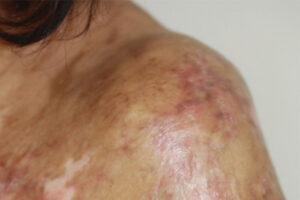Oncology
Chronic Graft-versus-Host Disease
Naive T Cells and Their Role in Chronic Graft-versus-Host Disease
Donor-naive T cells are drivers of allogeneic reactions and are associated with an increased risk of severe acute graft-versus-host disease (aGVHD) and chronic GVHD (cGVHD). The use of naive T-cell–depleted grafts may be a promising novel graft engineering strategy to reduce this risk.
T cells are a necessary evil in the context of allogeneic hematopoietic stem cell transplantation for hematologic malignancies. This is because donor T cells can not only cause severe cGVHD but also facilitate engraftment, protect against opportunistic infections, and eliminate residual tumor cells. Therefore, removing all the T cells from a transplant is associated with a relatively high rate of graft failure and a higher rate of infections and relapse, and it is not standard of care at this point.
Donor T cells help reconstitute the recipient’s immune system, with the population of donor T cells expanding after transplant. This provides the recipient with a measure of cell-mediated adaptive immunity until their own T cells and B cells begin recovering. The production of protective antibodies by B cells can be quite delayed after transplant, often taking many months or up to 1 year. This is why the vaccinations that are needed following stem cell transplant typically begin around 9 months after transplant.
Regarding the cure of hematologic malignancies, the donor’s effector cytotoxic T cells, which have previously been activated by antigen, are needed to kill residual tumor cells in patients with acute myeloid leukemia, acute lymphocytic leukemia, myelodysplastic syndrome, and other blood cancers. The tumor cells are killed, in part, because they are recognized as being foreign by the host T cells and because they produce neoantigens resulting from genomic mutations. Some of the donor T cells can recognize neoantigens and be activated by antigen-presenting cells to identify and kill the tumor cells.
This brings us to the question of the relevance of naive, antigen-inexperienced T cells. Warren D. Shlomchik, MD; Marie Bleakley, MD, PhD, MMSc; and colleagues developed a concept of naive T cells as drivers of allogeneic reactions such as cGVHD. Naive T cells, when transferred into the recipient, have a greater propensity to cause mayhem. They may potentially attack the recipient’s thymus, the organ that develops bone marrow–created thymocytes into T cells. The thymus uses positive and negative selection to produce effective T cells, so damage to the thymus would seriously impair the recipient’s T-cell recovery.
One idea that is being actively investigated in clinical trials is to selectively deplete the naive T cells from the graft and infuse only effector and memory T cells from the donor. In theory, this provides the antitumor and anti-infective activity, as well as engraftment benefits, while reducing the risk of severe aGVHD and cGVHD. Trials using graft manipulation to remove naive T cells have demonstrated the ability to reduce the risk of developing severe aGVHD and cGVHD, without an excess risk of relapse and nonrelapse mortality. A pivotal trial is underway to attempt to confirm these results and to determine if this is the best way to get adequate immune reconstitution without having to pay an excessive price in terms of severe aGVHD and cGVHD.
Bleakley M. Naive T-cell depletion in stem cell transplantation. Blood Adv. 2020;4(19):4980. doi:10.1182/bloodadvances.2020001888
Bleakley M, Sehgal A, Seropian S, et al. Naive T-cell depletion to prevent chronic graft-versus-host disease. J Clin Oncol. 2022;40(11):1174-1185. doi:10.1200/jco.21.01755
ClinicalTrials.gov. Graft versus host disease-reduction strategies for donor blood stem cell transplant patients with acute leukemia or myelodysplastic syndrome (MDS). Updated Novemer 18, 2023. Accessed December 1, 2023. https://clinicaltrials.gov/study/NCT03970096
Dekker L, Sanders E, Lindemans CA, de Koning C, Nierkens S. Naive T cells in graft versus host disease and graft versus leukemia: innocent or guilty? Front Immunol. 2022;13:893545. doi:10.3389/fimmu.2022.893545
Falkenburg JHF, Jedema I. Graft versus tumor effects and why people relapse. Hematology Am Soc Hematol Educ Program. 2017;2017(1):693-698. doi:10.1182/asheducation-2017.1.693
MacDonald KP, Hill GR, Blazar BR. Chronic graft-versus-host disease: biological insights from preclinical and clinical studies. Blood. 2017;129(1):13-21. doi:10.1182/blood-2016-06-686618
MacDonald KP, Shlomchik WD, Reddy P. Biology of graft-versus-host responses: recent insights. Biol Blood Marrow Transplant. 2013;19(suppl 1):S10-S14. doi:10.1016/j.bbmt.2012.11.005
van den Brink MRM, Velardi E, Perales M-A. Immune reconstitution following stem cell transplantation. Hematology Am Soc Hematol Educ Program. 2015;2015(1):215-219. doi:10.1182/asheducation-2015.1.215
Velardi E, Clave E, Arruda LCM, Benini F, Locatelli F, Toubert A. The role of the thymus in allogeneic bone marrow transplantation and the recovery of the peripheral T-cell compartment. Semin Immunopathol. 2021;43(1):101-117. doi:10.1007/s00281-020-00828-7











